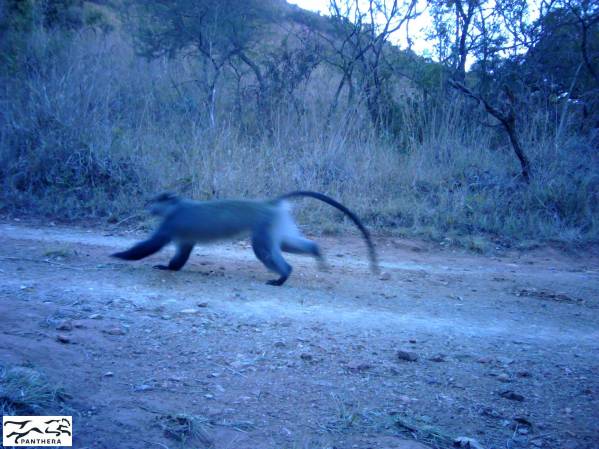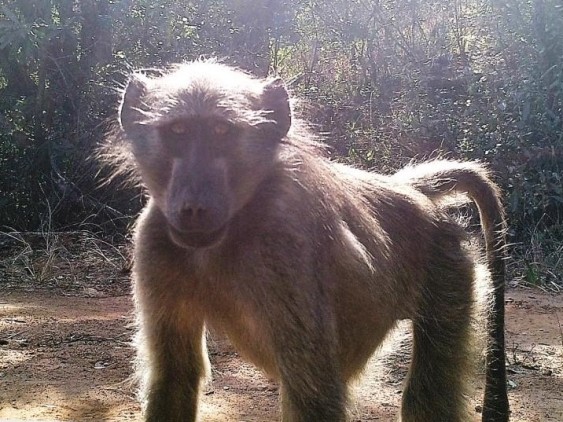
Camera trap photo of samango monkey
When you least expect it, someone comes along with evidence to solve a mystery. That is what happened with samango monkeys (Cercopithecus albogularis) on Mountainlands Nature Reserve.
Like author Emma Orczy’s elusive character the Scarlet pimpernel, no one was quite sure if they occurred there. And if someone claimed to have seen one, there was always the chance that it may have been a vervet monkey (Cerceopithecus aethiops).
Samangos differ from vervet monkeys in several ways. They are generally larger with longer and darker fur and have grey faces with black arms. Vervets have black faces, silver grey body hair, a white tail tip and their lower limbs are black.
Thanks to the camera traps that were placed on the reserve by NGO Panthera for their leopard survey there is now proof of samangos occurring on Mountainlands. One ventured from the forest canopy in Hyslop’s Creek in the southwest of the reserve onto the ground and luckily passed in front of a set of camera traps. When downloading the photos, Matthew Rogan from Panthera immediately identified it and shared the photos with us.
This brings the number of primates that occur on Mountainlands to five, namely the thick-tailed bushbaby also called the large-eared greater galago (Otolemur crassicaudatus), lesser bushbaby or mohol bushbaby (Galago moholi), chacma baboon (Papio cynocephalus ursinus), vervet and somango monkeys.

Chacma baboon selfie taken by a camera trap
The samango (from the Zulu name iNsimango) is widely distributed in sub-Saharan Africa and represents the southernmost extent of arboreal guneons on the continent. Two species are recognised: Cercopithecus albogularis is distributed from Ethiopia to South Africa, the South and East Democratic Republic of the Congo and Northwest Angola. Cercopithecus mitus occurs from the Congo-Oubangui River system to the East African Rift Valley, Northern Angola and North Western Zambia.*
C. albogularis occurs in the eastern regions of southern Africa. Three distinct genetic entities or subspecies are recognised namely C. a. schwarzi, C.a labiatus and C.a. erythrachus.
C. a. schwarzi is distributed in the northern Escarpment (Pilgrims Rest, Mariepskop, Magoebaskloof) area. A recent study argues that the Soutpansberg population should also be classified as C. a schwarzi instead of the current classification of C. a. erythrachus due to certain similarities.*
The distribution of C. a. labiatus and C. a. erythrachus coincides with the distribution of Indian Ocean coastal belt, Scarp and Afromontane forests. The two subspecies do not overlap in distribution.*
The southern limit of the habitat of C. a. labiatus is the Pirie forest in the Eastern Cape, stretching north-eastwards to the Kwazulu-Natal midlands. Samangos are not found in the large evergreen Tzitzikamma and Knysna forests, which poses the question why did they not radiate further south? This could relate to the forest history in southern Africa which is a subject in itself.
C .a. erythrachus is found in the Afromontane forests of Eastern Mpumalanga and Limpopo Province and Northern Kwazulu-Natal. It is likely that the one photographed by the camera traps may be this subspecies. However, only more colour photos and field research will conclusively identify it.
Although their range seems large, Afromontane and Indian Ocean coast belt forests in South Africa are also fragmented and small and under threat from land-use pressure, among other things. This leads to further fragmentation which may impact the habitat of the species. Nationally, the species is listed as “Vulnerable” (considered to face a high risk of extinction in the wild) in the Red Data Book of the Mammals of South Africa.
We are glad the forests on Mountainlands Nature Reserve are a safe haven for these monkeys and we hope to photograph more of them in future.
*Dalton DL, Linden B, Wimberger K, Nupen LJ, Tordiffe ASW, Taylor PJ, et al. (2015) New Insights into Samango Monkey Speciation in South Africa. PLos ONE 10(3): e0117003. Doi:10.1371/journal.pone.0117003



Recent Comments